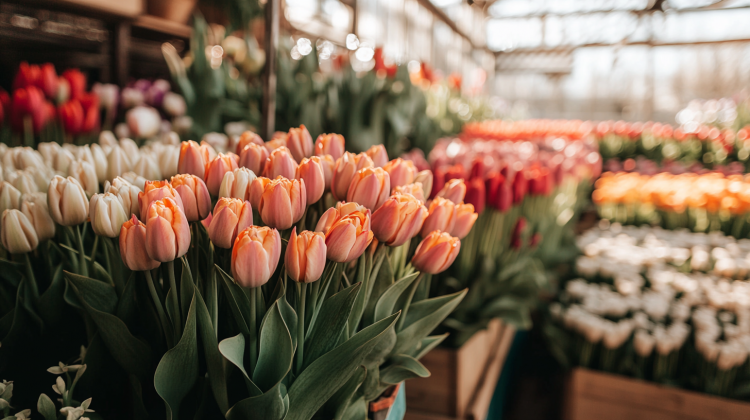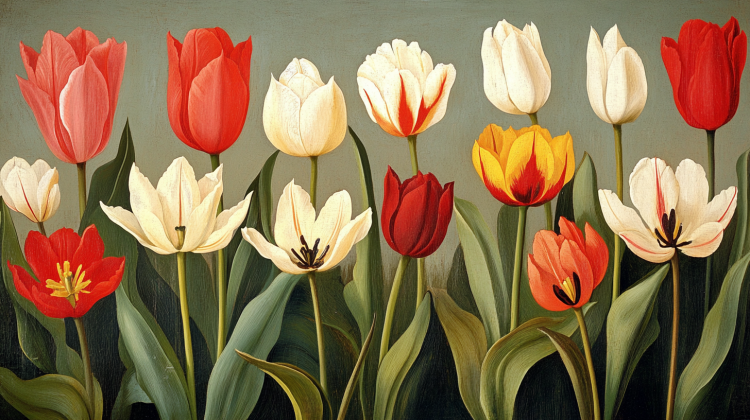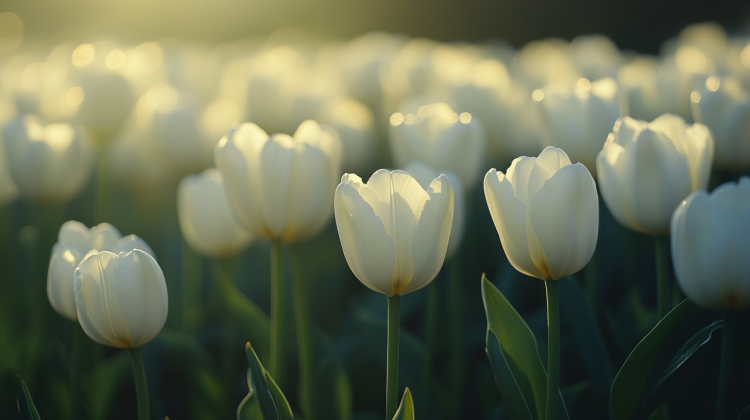

The tulip, a flower synonymous with beauty and sophistication, has a history as vibrant as its petals. Originating in the Ottoman Empire, tulips found their way to Europe in the 16th century, becoming a symbol of wealth and prestige. However, it was in the Netherlands that they truly made their mark, intertwining with the cultural and economic fabric of the Dutch Golden Age.
The story of the tulip is not merely one of horticulture but of human fascination and ambition. This unassuming flower, with its bold colors and elegant form, became a status symbol that transcended gardens to influence art, trade, and even social dynamics. Its journey from the palaces of the Ottoman Empire to the canals of the Netherlands mirrors the global exchanges that defined the early modern period.
During the 16th century, as European powers expanded their reach, exotic goods from the East captured the imagination of the elite. Tulips, with their striking symmetry and unusual shades, were unlike any flower native to Europe. They quickly gained popularity among botanists, collectors, and aristocrats, who saw them as both a botanical curiosity and a marker of refined taste. The Netherlands, already a hub of trade and cultural exchange, was fertile ground for the tulip’s meteoric rise.
As tulips grew in popularity, they became more than just flowers; they became symbols of human ingenuity and the transformative power of trade. The Dutch embraced tulip cultivation, experimenting with crossbreeding to produce rare and vibrant varieties. These efforts coincided with the Dutch Golden Age, a period of immense prosperity, innovation, and artistic achievement, during which the tulip became an emblem of the nation’s newfound wealth and ambition.
This unique interplay of culture, commerce, and horticulture set the stage for Tulip Mania, one of history’s most intriguing economic phenomena, and cemented the tulip’s enduring legacy as a cultural icon.


The Introduction of Tulips to Europe
Tulips first made their way to Europe in the mid-16th century, thanks to the growing interest in trade and cultural exchanges between the East and West. Originally cultivated in the Ottoman Empire, the tulip was highly prized for its exotic beauty, vivid colors, and unique shape. Ottoman gardens were known for their rich floral displays, and the tulip was considered a royal flower, often featured in intricate designs on textiles, ceramics, and manuscripts. European diplomats and traders visiting the empire were captivated by the flower’s elegance, leading to its eventual introduction to European gardens.
One of the most influential figures in bringing tulips to Europe was Carolus Clusius, a Flemish botanist and director of the botanical gardens at Leiden University in the Netherlands. Clusius obtained tulip bulbs from the Ottoman Empire in the late 1500s and began cultivating them, studying their unique properties and sharing his knowledge with other botanists. His work not only established tulips in European horticulture but also laid the foundation for the Netherlands’ eventual dominance in the tulip trade. Clusius’ garden in Leiden became the starting point for the spread of tulips across the continent.
The flower’s vibrant colors and ability to thrive in cooler climates quickly made it a favorite among European aristocracy. Tulips began appearing in royal gardens and private collections, often as symbols of wealth and sophistication. The rarity of certain tulip varieties, particularly those with unique patterns and hues, added to their allure. By the early 17th century, the tulip had become a sought-after luxury item, setting the stage for its extraordinary impact on Dutch society during the Golden Age. The tulip’s journey from the Ottoman Empire to the heart of Europe was not just a story of horticultural adaptation but also one of cultural fascination and ambition.
Tulip Mania: A Cultural and Economic Phenomenon
Tulip Mania, a term synonymous with speculative frenzy, was a short-lived but remarkable chapter in the history of the Dutch Golden Age. Beginning in the early 17th century, tulips transitioned from an exotic curiosity to an essential status symbol for the wealthy and aspiring middle class. Their vibrant colors, coupled with their rarity and the novelty of new patterns caused by viral infections in the bulbs, drove demand to unprecedented heights. By the 1630s, tulips were not just flowers but financial assets, their bulbs traded at markets and auctions as speculative investments.
The economic phenomenon of Tulip Mania was fueled by a growing class of merchants and traders in the Netherlands, a nation flourishing from its maritime trade and commerce. Tulip bulbs were sold and resold at rapidly escalating prices, with certain rare varieties—such as the coveted Semper Augustus—fetching sums equivalent to a craftsman’s annual income or even more. Contracts were drawn up to buy bulbs that had yet to be planted, giving rise to what many consider one of the earliest forms of futures trading. Speculation created an illusion of endless value, attracting participants from all walks of life, from seasoned traders to everyday citizens eager to profit.
However, this speculative bubble burst abruptly in February 1637. A single failed auction caused panic, leading to a sudden collapse in tulip prices. Buyers vanished, leaving sellers unable to unload their now-worthless bulbs. The economic fallout, while localized and not as catastrophic as often dramatized, left many individuals ruined. Tulip Mania became a cautionary tale of speculative excess, and its story has been retold for centuries as a metaphor for irrational markets.
Despite the financial collapse, Tulip Mania left a lasting cultural impact. The episode highlighted the social and economic dynamics of the Dutch Golden Age and underscored the Netherlands’ deep connection to the tulip. While the frenzy itself was fleeting, it forever linked the flower with notions of beauty, wealth, and the volatility of human ambition. Today, Tulip Mania remains a fascinating intersection of economics, culture, and botany, illustrating how a simple flower captivated an entire nation.
Tulips and Dutch Art
During the Dutch Golden Age, tulips transcended their role as mere garden flowers to become prominent symbols in Dutch art, particularly in the flourishing genre of still life painting. Artists of the time, such as Jan Brueghel the Elder and Ambrosius Bosschaert, began depicting tulips in their intricate and vibrant compositions, using the flowers to convey not only beauty but also deeper meanings about wealth, transience, and the natural world. These still life paintings often featured a wide array of flora, insects, and exotic objects, with tulips as central subjects, highlighting their rarity and the luxury associated with them.
Tulips were not just decorative elements in these paintings but were imbued with symbolic significance. Their striking appearance and vibrant colors were a reflection of the wealth and status of the patron who commissioned the work, often a prosperous merchant or aristocrat. In the context of Dutch society, where material prosperity was highly valued, these floral still lifes acted as visual representations of both economic success and personal taste. Tulips, with their exotic origins and high market value, became a status symbol within these private collections, illustrating the collector’s knowledge of global trade and their access to rare, expensive goods.
Beyond their association with wealth, tulips also symbolized the fleeting nature of life. In many still life paintings, the flowers were depicted at various stages of bloom, from fully open to wilting. This was a subtle nod to the transitory nature of beauty and material wealth, an idea deeply embedded in the vanitas tradition. Vanitas paintings, common during the period, used symbols like decaying flowers, rotting fruit, and wilting tulips to remind viewers of the inevitability of death and the futility of earthly pursuits. The tulip, in this context, was both a symbol of fleeting beauty and a cautionary reminder about the impermanence of life and possessions.
The enduring popularity of tulips in Dutch art during the Golden Age has left us with a rich legacy of paintings that offer insight not only into the flower’s cultural significance but also into the values and concerns of the time. These works remain some of the most celebrated in the history of European art, and tulips continue to be associated with the Netherlands’ golden period of artistic and economic achievement.


Modern Legacy of Tulips in the Netherlands
Today, tulips are an enduring symbol of the Netherlands, representing its rich cultural heritage and its global reputation as a leader in horticulture. The country produces billions of tulip bulbs annually, with many exported worldwide, making it the epicenter of the global flower trade. The tulip has become a cornerstone of Dutch identity, celebrated not only as a national icon but also as a symbol of innovation, resilience, and beauty.
One of the most prominent modern celebrations of tulips is the Keukenhof Gardens, located in Lisse, Netherlands. Known as the “Garden of Europe,” Keukenhof features over seven million tulips planted in stunning designs across its 79 acres. This annual spring event attracts millions of visitors from around the world who come to admire the breathtaking displays and learn about the Netherlands’ centuries-old tulip cultivation expertise. The festival also showcases the latest innovations in tulip breeding, highlighting the Netherlands’ continued role as a pioneer in horticultural science.
The tulip’s legacy is further celebrated during Tulip Festivals held across the country each spring. Events like Amsterdam’s Tulp Festival and the flower parades in Noordoostpolder allow locals and tourists to engage with the flower’s history and beauty. These festivals often feature vast fields of tulips in bloom, parades of flower-covered floats, and educational exhibits, reinforcing the tulip’s cultural significance while boosting tourism and the local economy.
Beyond its cultural impact, the tulip remains a major economic driver for the Netherlands. The Dutch flower auctions, such as the renowned Royal FloraHolland in Aalsmeer, facilitate the trade of billions of flowers and plants annually. The tulip, as one of the most popular flowers globally, plays a significant role in this industry, sustaining thousands of jobs and contributing to the country’s economy.
The tulip’s modern legacy is not just a testament to its beauty but also to the Netherlands’ ability to transform a simple flower into a global cultural and economic phenomenon. From its role as a symbol of the Dutch Golden Age to its current status as a celebrated national icon, the tulip continues to thrive, captivating the world and solidifying its place in the Netherlands’ identity.
The Timeless Appeal of Tulips
The tulip’s journey through history is a remarkable testament to the profound impact a single flower can have on culture, economy, and identity. From its humble beginnings in the gardens of the Ottoman Empire to its rise as a coveted luxury item in Europe, the tulip has captured human imagination like few other flowers. Its vibrant colors, unique shapes, and fascinating patterns transformed it into more than a botanical curiosity—it became a symbol of status, beauty, and ambition.
In the Netherlands, the tulip found fertile ground—both literally and figuratively—to become a defining feature of the Dutch Golden Age. Its role in the speculative frenzy of Tulip Mania underscored the flower’s ability to transcend its natural appeal and influence the economic and social fabric of an entire nation. Even after the bubble burst, the tulip retained its place in Dutch art, culture, and identity, becoming a lasting emblem of the creativity and innovation that characterized the era.
Today, the tulip’s legacy endures in modern Dutch culture and industry. It remains a symbol of the country’s ingenuity and global reach, celebrated in festivals, gardens, and the thriving flower trade. Its story serves as a reminder of the intricate connections between nature, human aspiration, and cultural expression. Whether admired for its historical significance or simply for its beauty, the tulip continues to inspire and enchant, proving that its timeless appeal will never fade.





